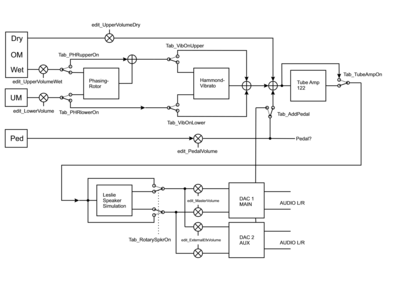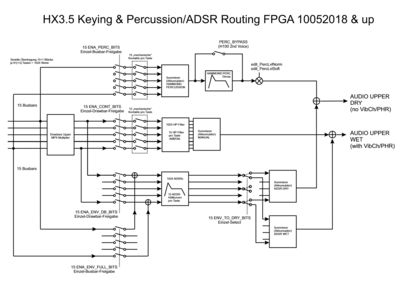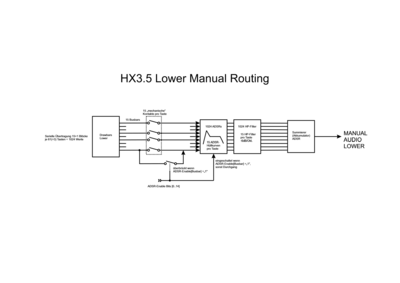HX3.5 Backgrounder
Preface
Due to many requests I decided to design a HX3.5 mainboard mechanically compatible to HX3.4, there is no need for any hardware change (if you don't want to use the new features).
However, some changes apply:
- Additional analog multiplexer connector for up to 64 analog control inputs
- New Reverb DSP
- USB MIDI input/output (internal connector), just add a USB socket
Features
The new much larger HX3.5 6th generation FPGA (Field Programmable Gate Array) yields a lot of new features to mimic all classic organs - Hammond H100 as well as Wersi, Farfisa, Böhm, Vox Continental etc., along with the legendary HX3 sound: The new high-performance reverb DSP is capable of producing additional GM voices for piano, vibraphone etc. (optional licence basis). GM voices may be routed to lower manual or pedal also. You will find a following list of all new features:
- Support of up to 15 busbars per manual as well as pedal. Higher 6 busbars are routed as "mixtures" to additional 3 drawbars. Busbar mix to each drawbar is adjustable, as well as harmonic (for example 16/27' or 4/5', up to 1/4', or even 10 2/3')
- Any busbar of upper/lower manual may be routed to its own ADSR/VCA envelope circuit instead of "mechanical" contacts (FPGA provides nearly 1000 ADSR/VCA circuits for each manual) for polyphonic percussion on selectable drawbars, sustain or just noiseless "electronic" keying
- "Second Voice" feature as found on Hammond H100 (particular drawbars routed to Vibrato/Chorus, others "dry")
- Additional "electronic" vibrato/chorus/ensemble circuit like Wersivoice or Böhm Phasing Rotor, may also be used and parametrized as additional "Celeste" Vibrato for Hammond H100. Simulation of three TDA1022 CCD delay ICs, adjustable modulation and audio mix for each.
- Loadable generator wavetables for non-Hammond organs, from pure sine to cheesy or sawtooth-like sounds. Each generator octave may have its own waveform.
- Different loudness curves or linear mode for swell pedal
- Bass pedal up to 61 keys, full ADSR envelope as on manuals (always on)
- Up to 15 drawbars per manual, either 4 or up to 15 pedal drawbars, 4 additional drawbars for ADSR envelope plus one "harmonics decay" drawbar per manual (adjusts non-simultaneous decay of harmonics for a decent string bass effect)
- Volume drawbars for tube amp gain, volume, tone (as before), plus separate upper, lower and pedal volumes
- Former "Output Configuration" menu deleted. Instead, digital audio "Inserts" act as below. Output A/B select button becomes "Add pedal to tube amp". When off, pedal signal is post-mixed to digital output.
- 16 Buttons/switches as found on mk4, plus (optional): 8 Buttons for Wersivoice/Phasing Rotor setup, 2x 12 Buttons for routing a drawbar to ADSR envelope, 1 Button for "Second Voice" effect, 4 Buttons for effect "Inserts" (tube amp, rotary speaker sim, PhasingRotor/Wersivoice to lower and upper)
- Generator size adjustable from 72 to 96 notes
- Separate (de-)tuning of each generator note for emulation of Conn and other theater organs
- Firmware and FPGA update via MIDI SysEx or via FTDI USB to serial adapter. Optionally via SD Card (external slot), or on-board Micro SD card, very dependable, there is no need for an update application
- Persistent EEPROM basic settings (user name, licences, scan configuration etc.), will not overwrite the update
- Scripts (human-readable text files) running from SD Card to set any amount of parameters (i.e. for "overall organ type" presets), selectable from MenuPanel
- Support for SysEx communication
- New menu behaviour for faster scrolling and easy parameter changes (114 entries)
- All parameters may be controlled by MIDI without any buttons/drawbars connected
HX3.5 mainboard is compatible with all older accessories including the drawbar boards. The new MPX drawbar concept supports up to 64 additional analog inputs. The new drawbar assembly design contains own multiplexers, as the new design supports up to 64 drawbars or potentiometers (12 drawbars per manual/pedal plus additional controls). This cleans up wiring, as only one 10-wire bus cable is needed to connect them (up to 64 analog inputs and 64 switches/buttons possible). With the new design, all drawbars are connected "daisy-chained" in a row by 10-wire flat ribbon cables, so there is no need for special MPX type drawbar boards to support 2 DB sets per manual.
The new DB concept was mandatory for connecting more drawbars per manual (as on H100 for instance) as well as additional ADSR/Volume drawbars. DB boards will be available in groups or 6 (Pedal/Sustain, ADSR control, Volume control), 2x6 (H100-type organ manuals) or 9 drawbars (classic B3 manuals). It is activated by a special parameter in HX3.5 Editor's "System Init" section.
HX3.5 firmware provides 100 overall presets (complete organ setups), 16 drawbar "voice" setups (16 selectable by Preset16 board, 12 selectable by Preset12-2 board) plus 24 piano/bass setups per manual and pedal (selected from a choice of 128 GM voices). It is possible to play the piano/bass voices on all manuals, even on the pedal. Menu system has been revised completely.
USB supports USB MIDI (all channels except 10 drums). For now, full parameter editing is only possible HX3.5 Manager (more than 800 parameters).
Audio Routing
HX3.5 does not have configurable audio outputs like HX3 mk4; instead, an effect insert scheme has been implemented. The plain organ signal may be routed through various "effects" (if not bypassed): B3 Vibrato, Phasing Rotor, 122 Amp Simulation and Rotary Cabinet/Speaker Simulation. Each effect may be enabled or disabled. Bass Pedal Signal may be added to 122 Amp input or bypassed to output stage. See Picture HX3.5 main routing diagram for details.
In the diagrams, the prefix "tab" denotes a tab switch, accessible by "real" button switches, menu entries, MIDI CCs and HX3.5 Editor parameter changes. The prefix "edit" denotes continuous parameter values (analog input control voltages, menu values, MIDI CCs and parameters).
Upper Routing
While HX3 mk4 only features a "mechanical" key gating, HX3.5 adds an Electronic Gating (EG) stage. Each busbar harmonic may be routed to mechanical contacts, to EG circuit or both. EG stages consist of 15 complete ADSR/VCA circuits per key, adding up to a total of 915 ADSR/VCA circuits per manual. Percussion voicing may consist of all 12 drawbar harmonics, not just 4' and 2 2/3' as on HX3 mk4.
As each of the 915 ADSRs may have it's own parameters, this allows for a "pluck" or "harmonic breakup over time" effect as found on complex fourier synthesizers. This is also true for lower manual and pedal.
Lower Routing
For the lower manual, you may choose between mechanical contacts and electronic gating (EG) for each drawbar individually. It is not possible to activate both for the same harmonic. EG stages consist of 15 complete ADSR/VCA circuits per key, adding up to a total of 915 ADSR/VCA circuits per manual. Percussion voicing may consist of all 12 drawbar harmonics, not just 4' and 2 2/3' as on HX3 mk4.
As each of the 915 ADSRs may have it's own parameters, this allows for a "pluck" or "harmonic breakup over time" effect as found on complex fourier synthesizers. This is also true for upper manual and pedal.
Pedal Routing
Pedal routing is similar to lower routing, except the "mechanical" contacts. Pedal logic consists of a total of 915 ADSR/VCA circuits to support 15 harmonics and up to 61 keys. Pedal drawbar set may consist of 2, 4 or 12 drawbars (selectable by parameter). When in 2- or 4-drawbar mode, upper harmonic levels (virtual drawbar positions) are derived from 16'/8' drawbars by a formula.
From firmware version 5.65 and up, pedal audio may be routed through lower manual vibrato like on B3 or dry.
Switch/Button and Analog Input Remap
Every physical control (analog input voltage, button inputs) may be re-routed to any internal tab resp. analog function. As a factory default, HX3.5 button/switch and analog remaps are programmed for compatibility with HX3 mk4. Note: Different from HX3 mk4, upper analog input pin 12 may asssigned deliberately (factory default: not assigned). Use HX3.5 Editor parameters 5000..5063 and 5100..5163 to remap inputs as desired.
Additional GM Sounds
The onboard multicore DSP allows for synthesis of standard GM sounds. GM Soundbanks are stored in the DSP's own sample Flash-ROM.
128 standard GM voices are available as a selection on #16 to #39 on upper, lower or pedal Voice. They appear on HX3.5 mainboard audio jacks only, not on Extension Board Leslie output. If a particular Voice is set to a GM sound, it will be saved as Overall Preset also if you do so. The DSP will add the reverb as set by organ tabs.
You may change the GM program number assigned to each Voice number with HX3.5 Editor, "DSP/GM Setup" group, "GM Voice Assignment".


